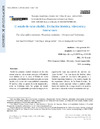Identificador persistente para citar o vincular este elemento:
https://accedacris.ulpgc.es/jspui/handle/10553/114511
| Título: | El estado de valor añadido: evolución histórica, relevancia y limitaciones | Otros títulos: | The value added statement. Historical evolution, relevance and limitations | Autores/as: | Déniz Mayor, José Juan Arteaga Arzola, Luis Miguel Manrique de Lara Peñate, Casiano |
Clasificación UNESCO: | 530301 Contabilidad financiera | Palabras clave: | Contabilidad Estado de valor añadido Grupos de interés Accounting Stakeholders, et al. |
Fecha de publicación: | 2022 | Publicación seriada: | Trascender, Contabilidad y Gestión | Resumen: | Desde los primeros modelos formales de los años setenta hasta sus más recientes versi ones , el Estado de valor añadido (o en su caso, el Estado de rentas generadas y distribuidas) ha estado asociado, en cierta medida, a la noción de responsabilidad corporativa. Al mostrar cómo se genera la renta empresarial y cóm o se distribuye entre los grupos de interésrelevantes, se ha pretendido presentar la imagen de la organización como una coalición de intereses, una “gran familia”. Tras una época de declive, ahora comienza a gozar de una nueva vida gracias a la Global Reporting Initiative y las normas legales de los organismos oficiales de la Unión Europea. No obstante, parece oportuno volver a analizar cuálesfueron los motivos de su auge inicial y su aparenteabandono al objeto de evaluar si realmente este tipo de informes es necesario hoy en día, para qué y para quién. Since the first formal models in the seventies to its most recent versions, the value added statement (or in its case, the statement of income generated and distributed) has been associated, to some extent, with the notion of corporate responsibility. By displaying how business income is generated and how it is distributed among the relevant stakeholders, it has been tried to present the image of the organization as a coalition of interests, a "big family". After a period of decline, it seems to enjoy a new life thanks to the Global Repor ting Initiative and legal rules from official bodies of the European Union. However, it seems appropriate to re -analyze what were the reasons for its initial boom and i ts later apparent forgetting in order to assess whether this kind of report is really necessary today, for what and for whom. |
URI: | https://accedacris.ulpgc.es/handle/10553/114511 | ISSN: | 2448-6388 | DOI: | 10.36791/tcg.v7i19.135 | Fuente: | Trascender, contabilidad y gestión [ISSN 2448-6388], v. 7 (19), p. 107-149, (Enero –Abril 2022) |
| Colección: | Artículos |
Visitas 5
45
actualizado el 10-ene-2026
Descargas
15
actualizado el 10-ene-2026
Google ScholarTM
Verifica
Altmetric
Comparte
Exporta metadatos
Los elementos en ULPGC accedaCRIS están protegidos por derechos de autor con todos los derechos reservados, a menos que se indique lo contrario.
